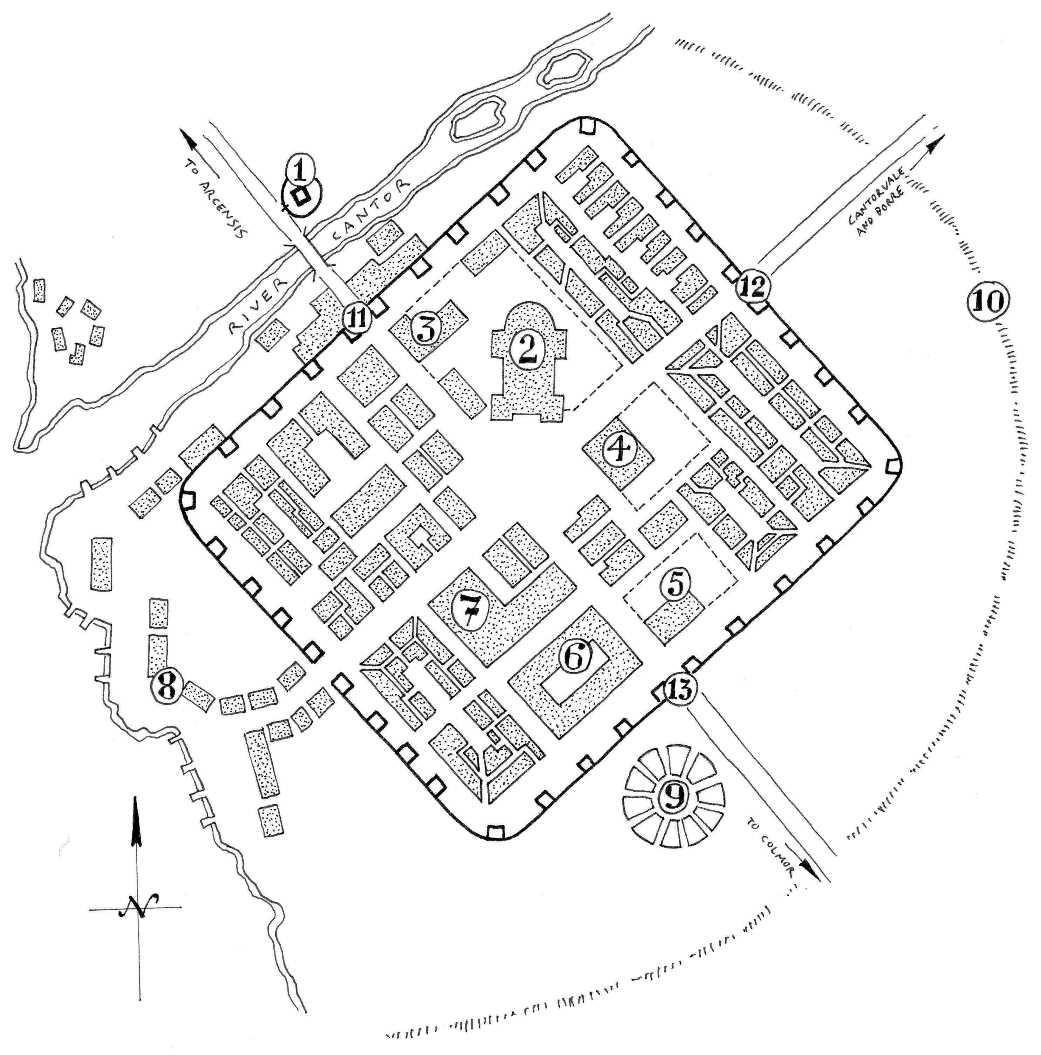|
Plan of Cantorbridge in about 480 A.S. The “Giant’s Pen” (section 10 below) would actually be larger, but I was limited by the size of the paper I was scribbling on – you can assume it would be at least twice as far from the city walls as it is depicted.
I wrote the article below for the “Pendragon Gazette”, which was a player supplement I produced as part of a long-running Dragon Warriors game I ran set in 5th Century Ellesland; the time of Vallandar Pendragon.
Much of this may have disappeared by the 10th Century except, maybe, for the Church of the Saviour, the Bishop’s Palace (although maybe rebuilt?) and the general outline of the walls. Maybe the “Giant’s Pen” would now enclose further houses as the population grows and needs to spread beyond the old Selentine walls?
(Apologies to anyone who has their own view / plans of Cantorbridge. Feel free to ignore this!)
A Visit To Cantorbridge
With Ongus fallen into the hands of the Kurlish barbarians, Cantorbridge is now the foremost city of Albion, if not of Ellesland. Here can be found the home of the True Faith in Ellesland, as well as one of the favoured stopping places for the High King’s Court.
Cantorbridge as we know it was founded in 63 A.S. following a successful Selentine campaign against our forefathers, but the original city is much older. Beneath the current city are the ruins of a far older city and these form ‘catacombs’ which adventurers periodically explore to search for long-lost riches.
For those who prefer an easier life, Cantorbridge is one of the main markets of Ellesland and if what you’re looking for can’t be bought here, you’re unlikely to find it elsewhere. There are also quite a few sights to see for those who are simply curious…
1) Tower of Garofula. A stone tower surrounded by a ditch and palisade. A permanent garrison guards the access to the north of the city and the important Cantor Bridge.
2) Church of the Saviour. Founded in 326 A.S. and completed in 372 A.S., this is the centre of the True Faith in Ellesland. It is a vast church (or ‘cathedral’ as the True Faith priests call it) with a high nave and three solid towers. It has tiled roofs, but what impresses most are its coloured windows bathing the inside in multicoloured light. There is a perpetual choir of 200 monks that sing hymns to the One True God.
3) The Bishop’s Palace. A great Selentine house kept in good repair. Includes a vast hall and an enclosed colonnaded garden. Bishop Isatis resides here as, until recently, did Archbishop Guitard. A walled enclosure surrounds the palace and cathedral within which can be found orchards, herb gardens, stables, guest quarters and a smithy.
4) Praetor’s Palace. These days often referred to as the Royal Palace as the High King stays here when in Cantorbridge, this is a two-storey building with a courtyard inside the main entrance. On the far side of the courtyard from the main entrance is the great hall which runs the entire width of the palace and has pillars supporting the floor above. This is the home of Praetor Marullinus Garva and serves as Royal Court, judicial court and guest quarters for high ranking visiting nobles. The walls behind the palace enclose impressive gardens.
5) Church of St Nilas. A church dedicated to an early martyr of the True Faith. A well-built square building, this was once a Pagan temple and had a surrounding colonnade which has now vanished. The roof is now of thatch, the original roof having been removed so the tiles could be used on the Church of the Saviour. Adjoining it are a herb garden and cemetery.
6) Hospital. A great 2-storey building enclosing a colonnaded courtyard. 20 nuns led by Mother Helena run the place, where they treat the sick and injured – in exchange for a small ‘donation.’
7) The Baths. A large, intricate building in fairly good condition. It is now mostly used as a guesthouse and stables for the entourage of visiting nobility. Although in a state of some disrepair, the Pendragon has had engineers brought in to work on the building and the baths are partly working again. There are also some splendid examples of Selentine mosaics to be seen here.
8) The Docks. Perpetually busy, the area is packed with warehouses and there is a permanent fish market.
9) The Amphitheatre. A vast, circular ruined building with arches all the way round giving access to its labyrinthine interior. The central arena is actually below ground level, and there are passageways that run below that. Normally it is the haunt of beggars and rats, but the place is periodically cleaned out to stage major events and fairs, as it makes an excellent meeting place. Some of the deeper tunnels here give access to the Undercity, but few venture there…
10) The Giants’ Pen. An ancient, ruined rampart. A shallow ditch lies outside a 5m high grassy ridge, overgrown in places with bushes and brambles. Here and there can be seen cyclopean stone blocks poking out between the roots of trees and bushes.
11) Gryphon Gate. Gives access to the Cantor Bridge. A very worn bas-relief of a gryphon looks down from the archway above the gate. All the gates of Cantorbridge open at sunrise and shut at sunset.
12) Buccelan Gate. A weathered bas-relief of a horse is carved above this gate, which gives access to the main road to Hurstington and Borre.
13) Eagle Gate. The gate leading to Colmor and Escarbensis. As the name suggests, a bas-relief of an eagle is set above the archway.
| Attachments: |

cantorbridge3small.jpg [ 128.04 KiB | Viewed 8733 times ]
|
|



